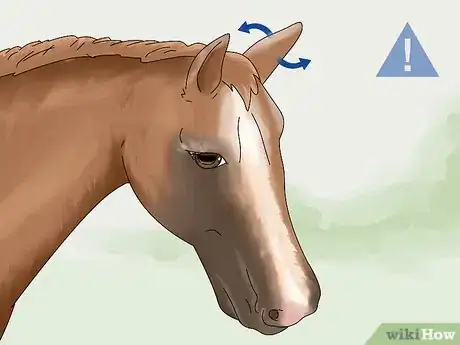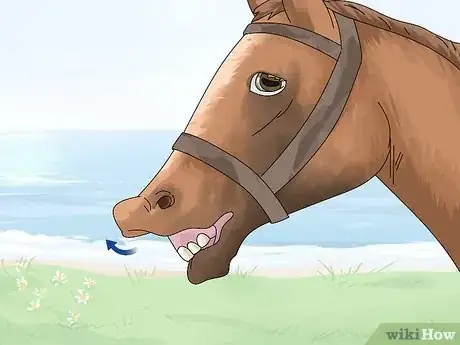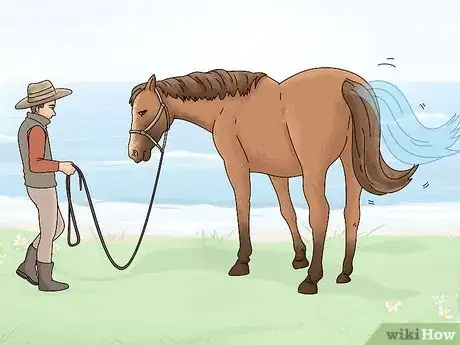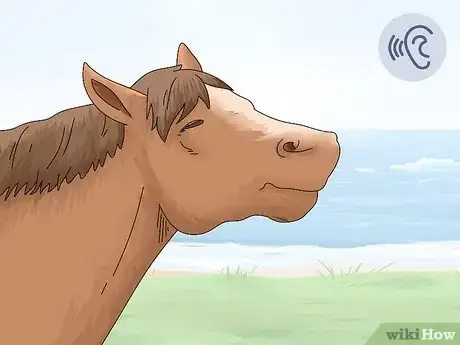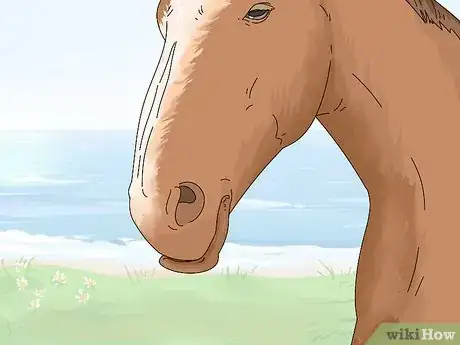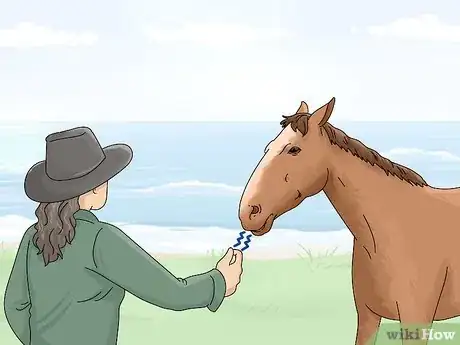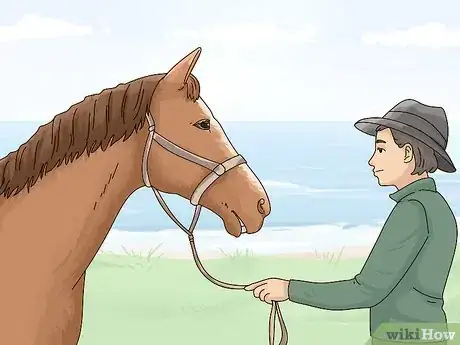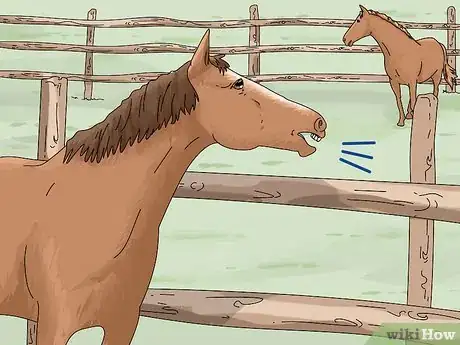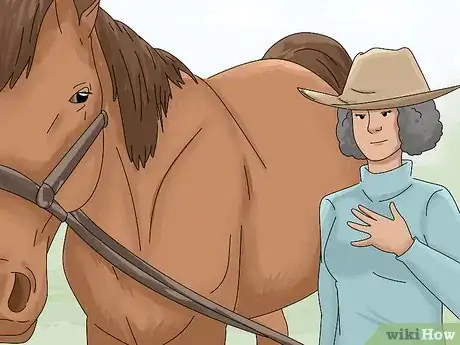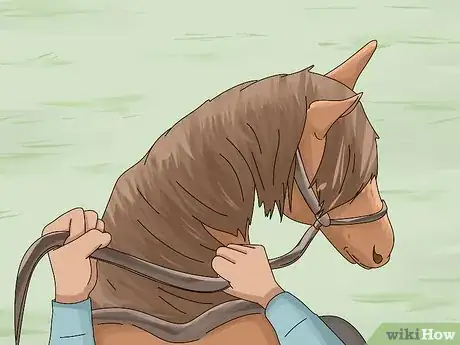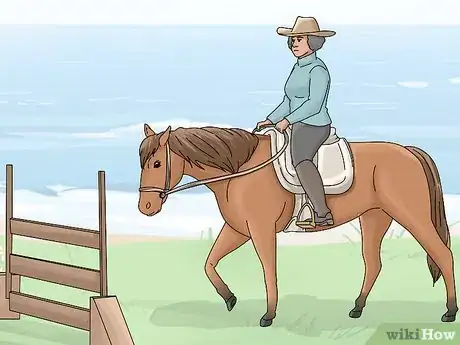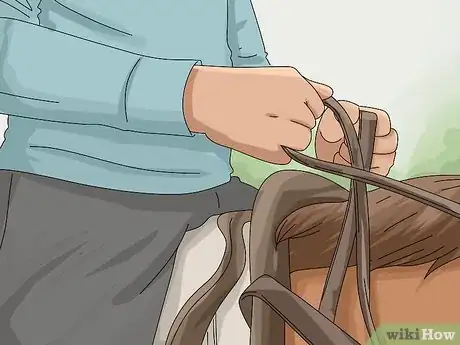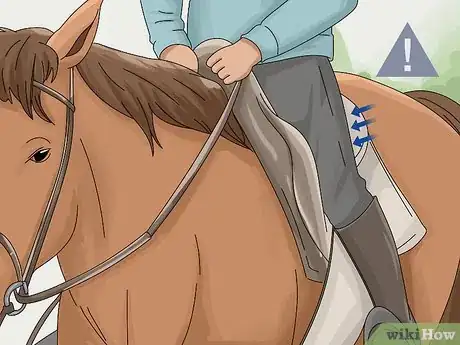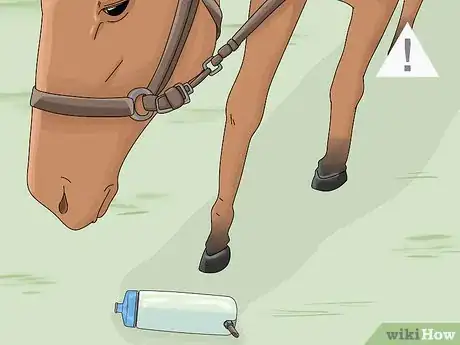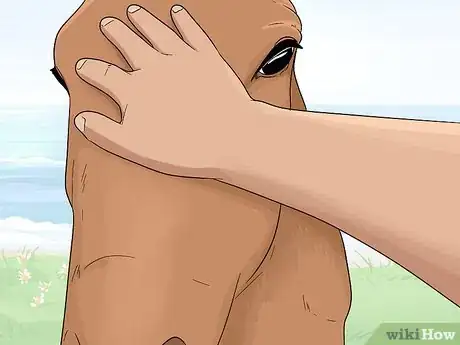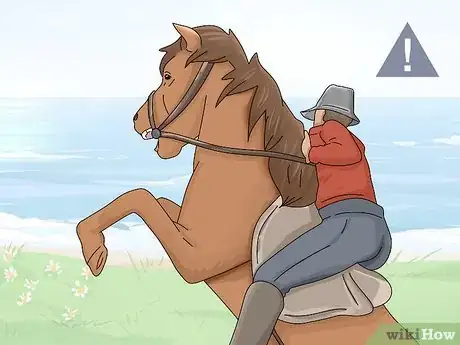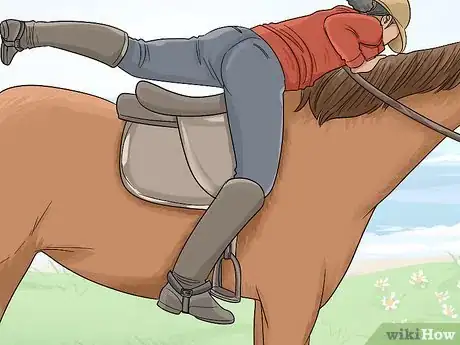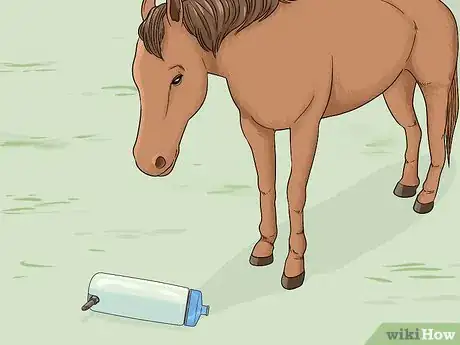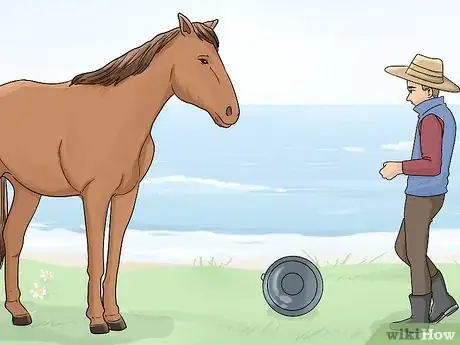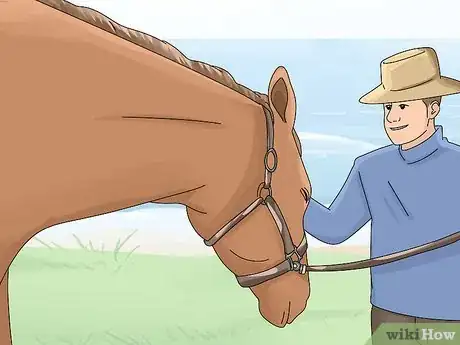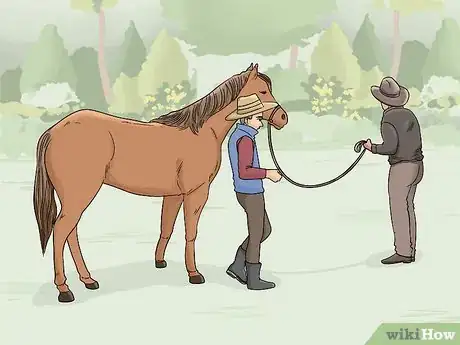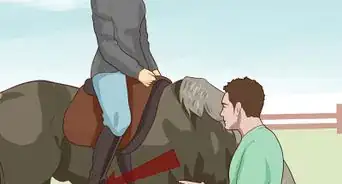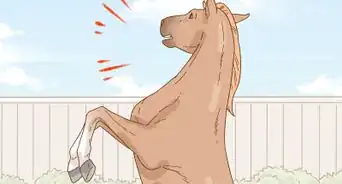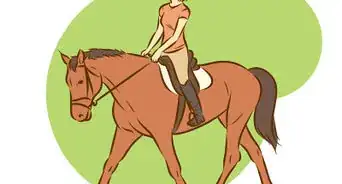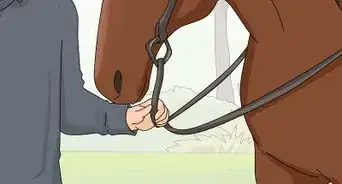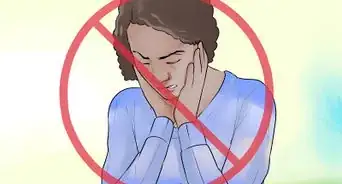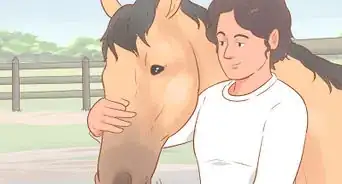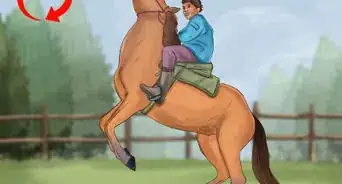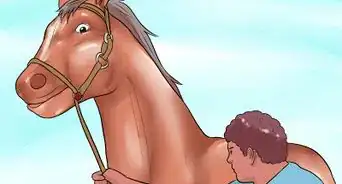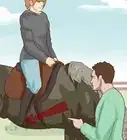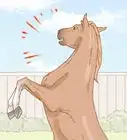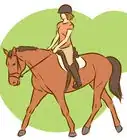This article was co-authored by Kate Jutagir. Kate Jutagir is an Equestrian Specialist, Hunter/Jumper Trainer, and the Owner of Blackhound Equestrian, a premier training barn located on 65 acres in Castro Valley, California. Originally designed to be a riding school used as a springboard for dedicated students into careers in the sport, Blackhound Equestrian has grown into a hunter/jumper training program for all levels focusing on providing a solid foundation needed for personal advancement in the sport. Kate has over 25 years of equestrian instruction and training experience. Her focus on developing horse and rider partnerships provides a complete equestrian education for both beginners and advanced riders alike.
This article has been viewed 43,392 times.
Horses are prey animals, meaning that they are naturally wary and cautious about new situations, places, and people.[1] In the wild, horses stay alive by having sharp instincts and a fast flight response to danger. It is important for anyone who will be around horses to recognize when a horse is frightened for their own safety and that of the animal.
Steps
Reading a Horse's Body Language
-
1Pay attention to his ears. The position of a horse's ears says a lot about his mood.[2] Often, their ears will point toward whatever they're afraid of at that moment.[3] In addition, you might notice:
- If his ears are flicking back and forth, your horse is probably frightened or overly stimulated. He is flicking his ears around to pinpoint the source of his anxiety.
- If his ears are perked forward, he is alert and interested in his surroundings.
- If his ears are pinned back tightly, he is angry or feeling aggressive and may be preparing to lash out with a kick or bite.[4]
- If his ears are turned outward to the sides, he is relaxed and not paying attention to his surroundings. Be careful not to startle him by approaching or reaching out toward him suddenly.
-
2Examine his head carriage. When a horse suddenly raises his head when being ridden, he is examining something far away and is no longer paying attention to you. He may be preparing to bolt or shy away from something.
- You might also notice your horse's muscles getting very tense. In addition, their eyes might get wide and their nostrils might flare.[5]
- If your horse raises his head high while rounding his back, swishing his tail, or pinning his ears back, he may be in pain. Stop and check his legs and around his tack to be sure nothing is hurting him.
Advertisement -
3Watch his muzzle. When your horse curls his upper lip while breathing in and out, he is examining a scent in the air. This may be a sign that something in the immediate environment is causing him stress.
-
4Notice when he stomps or paws at the ground. Your horse may be simply trying to get rid of a pesky fly, but it might be something more serious.
- Pawing at the ground with a raised leg usually indicates boredom or restlessness.
- Excessive stomping may mean your horse is annoyed with you for some reason. If you don't resolve the situation, your horse may move on to more extreme behavior next.
-
5Watch his tail. Horses communicate using body language, and the tail is a good indicator of mood. If your horse is slowly flipping his tail from side to side, he is probably just trying to swat a fly. But quick tail flips, or a clamped-down tail, indicate stress.
- A horse clamps its tail down by tucking it lower into its hindquarters. If your horse is pressing his tail down against his body, this is a sign that he is nervous or frightened.
- If your horse is jerking his tail rapidly up and down or side to side, he is probably irritated or angry and may be about to buck or kick.
Interpreting Fearful Horse Sounds
-
1Listen for a snort. When your horse snorts, he holds his head high with his mouth shut, and exhales forcefully through his nose. This causes a loud fluttering sound in the nostrils which lasts for about a second.[6]
- Snorting indicates your horse has identified a potential danger, and is investigating it.
- If your horse shies away from something after snorting, this indicates fear.
-
2Pay attention when your horse blows. Blowing is similar to snorting, but without the loud flapping sound in the nostrils. It makes a softer sound.[7]
- Horses do this when they are curious about something, or when meeting another horse.
- If the horses get along, they will calmly continue to snort in greeting. If they feel threatened, one or both animals will squeal or nip at the other.
- If your horse blows and then becomes tense or shies away from an object, he is showing signs of fear.
-
3Disregard a nicker. When your horse nickers, his vocal chords emit a vibrating sound through his closed mouth. This does not indicate fear – it is a greeting directed at a person or another horse.[8]
-
4Analyze the situation when your horse squeals. When your horse squeals, he creates a noise that can either be short and soft, or long and loud. A loud squeal can be heard from quite far away.
- A squeal indicates resistance to something – your horse may not be afraid, exactly, but he is not happy about what he's being asked to do.
-
5Disregard a neigh or whinny. A neigh is a very long sound that is the combination of a squeal and a nicker. A horse neighs when he is separated from other horses.
- A whinny or neigh does not indicate fear. Your horse is trying to determine where his companions are.
- When another horse hears a neigh, he will usually whinny in return. This lets the first horse know he isn't alone.
Handling a Frightened Horse
-
1Remain calm. Horses can detect fear in humans. Your horse will become even more afraid if he senses that you are worried about a situation.[9]
-
2Use a one-rein stop. Pull your horse's head back toward your foot, using only one rein. This will often stop a horse more effectively than by using two reins.
-
3Face the danger, but allow him to back away from it. Don't try to turn your horse away from the object that spooked him – he is more likely to panic because he can no longer see the threat.
- Point your horse's head toward the worrisome object, so he can get a clear look at it.
- Meanwhile, allow your horse to back away or step to the side.
-
4Control the reins. Avoid tugging or pulling at the reins, which will only make your horse more anxious. Keep your horse under control with gentle pressure.
-
5Avoid gripping with your legs. Retain your balance as best you can without gripping too tightly with your legs. This will reassure your horse that you are in control of the situation.
- Push gently on your horse's neck or withers, which will help loosen your legs while anchoring you in the saddle.
-
6Avoid the scary object. Don't force your horse to go over and confront the water jug or fallen lead line, or whatever is scaring him. Your horse will probably panic, and it will damage the trust he has in you.
-
7Praise your horse if he is under control. If your horse seems to be afraid, but is still allowing you to control him, be sure to praise his behavior. Speak in a calm, reassuring tone of voice.[10]
-
8Avoid praise while your horse is panicking. Don't praise your horse while he is shying away from something, or you will reinforce a behavior you don't want.[11]
-
9Dismount. If your horse is truly in a panic and you are unable to bring him under control, jump to the ground and get to safety. A frightened horse can cause very dangerous situations.
-
10Use caution if you're working from the ground. A frightened horse might try to turn and bolt from the danger. If you're in the way, the horse could step on you or they could kick out as they pass.[12]
- The horse might also have a fight response—you can usually tell that's happening if they pin their ears flat against the back of their head. If that happens, they could charge, kick, or bite you.[13]
Training a Spooky Horse
-
1Desensitize your horse to harmless things that frighten him. If your horse often spooks at a particular type of object, like tarps or bicycles, try “following.” This may help your horse become accustomed to these objects.
- Drag (or roll) the object around in front of your horse, leading away from him. Allow your horse to follow you.
- Don't approach your horse with the object, or drag it towards him – this will probably frighten him.
- Pull the object around calmly, until your horse becomes curious and comes to explore it. This may help get rid of his fear of this type of object.
-
2Try gradually riding closer. One way to help your horse become accustomed to a particular scary object in the ring is to gradually direct him closer to it.[14]
-
3Praise your horse if he is under control. If your horse seems to be afraid, but is still allowing you to control him, be sure to praise his behavior. Speak in a calm, reassuring tone of voice.[15]
- Place the scary object at the far end of your ring or paddock, and ride your horse in small circles in the center of the ring.
- Gradually ride in wider circles until you are closer to the object. Don't get so close that your horse spooks.
- Praise your horse for remaining in control, and repeat the exercise another time. Ride closer to the object each time.
-
4Work with a trainer. If you don't have much experience with horses, find a local trainer who will work with you and your horse together, to establish trust between you.[16] A good trainer will assign exercises you can do with your horse, to strengthen the bond between horse and rider.
- You can also read books about horse care and behavior.[17]
Expert Q&A
Did you know you can get expert answers for this article?
Unlock expert answers by supporting wikiHow
-
QuestionHow do you deal with a scared horse?
 Jessica RudeJessica Rude is an Equine Expert currently working on a cutting horse ranch in Valley View, Texas as well as a horseback riding center in Princeton, Texas. Previously, she was a Trail Guide and Wrangler at a camp and retreat center In Dallas, Texas, and an Equine Breeding Barn Manager at a reining ranch in Tioga, Texas. Jessica holds a Bachelor’s degree in Animal Science with an emphasis in Equine Science from Tarleton State University. She has studied equine nutrition, reproduction, and management. Jessica specializes in equine breeding as well as instructing horseback riding lessons, leading trail rides, recognizing equine illnesses, and administering treatments.
Jessica RudeJessica Rude is an Equine Expert currently working on a cutting horse ranch in Valley View, Texas as well as a horseback riding center in Princeton, Texas. Previously, she was a Trail Guide and Wrangler at a camp and retreat center In Dallas, Texas, and an Equine Breeding Barn Manager at a reining ranch in Tioga, Texas. Jessica holds a Bachelor’s degree in Animal Science with an emphasis in Equine Science from Tarleton State University. She has studied equine nutrition, reproduction, and management. Jessica specializes in equine breeding as well as instructing horseback riding lessons, leading trail rides, recognizing equine illnesses, and administering treatments.
Equine Expert
References
- ↑ Jessica Rude. Equine Expert. Expert Interview. 18 September 2020.
- ↑ Kate Jutagir. Equestrian Specialist & Trainer. Expert Interview. 31 March 2020.
- ↑ Jessica Rude. Equine Expert. Expert Interview. 18 September 2020.
- ↑ Jessica Rude. Equine Expert. Expert Interview. 18 September 2020.
- ↑ Jessica Rude. Equine Expert. Expert Interview. 18 September 2020.
- ↑ http://www.equusite.com/articles/behavior/behaviorSounds.shtml
- ↑ http://www.equusite.com/articles/behavior/behaviorSounds.shtml
- ↑ http://www.equusite.com/articles/behavior/behaviorSounds.shtml
- ↑ http://animals.mom.me/calm-horse-startle-3664.html
- ↑ http://animals.mom.me/calm-horse-startle-3664.html
- ↑ http://horsetalk.co.nz/saferide/121-janesavoie.shtml#axzz4ANqZiuHo
- ↑ Jessica Rude. Equine Expert. Expert Interview. 18 September 2020.
- ↑ Jessica Rude. Equine Expert. Expert Interview. 18 September 2020.
- ↑ http://horsetalk.co.nz/saferide/121-janesavoie.shtml#axzz4ANqZiuHo
- ↑ http://animals.mom.me/calm-horse-startle-3664.html
- ↑ Kate Jutagir. Equestrian Specialist & Trainer. Expert Interview. 31 March 2020.
- ↑ Kate Jutagir. Equestrian Specialist & Trainer. Expert Interview. 31 March 2020.
About This Article
To tell if a horse is frightened, watch its ears to see if they're flicking back and forth, perched forward, or turned outwards, which are all signs that a horse is alert and anxious. Also, look at what your horse is doing with its tail. If its tail is pressed down against its body, or if its quickly jerking its tail back and forth, it could be frightened by something. You should also listen and watch for forceful exhales, like your horse is snorting, which could indicate that it's afraid. For more tips from our Veterinary co-author, like how to deal with a frightened horse, scroll down.

